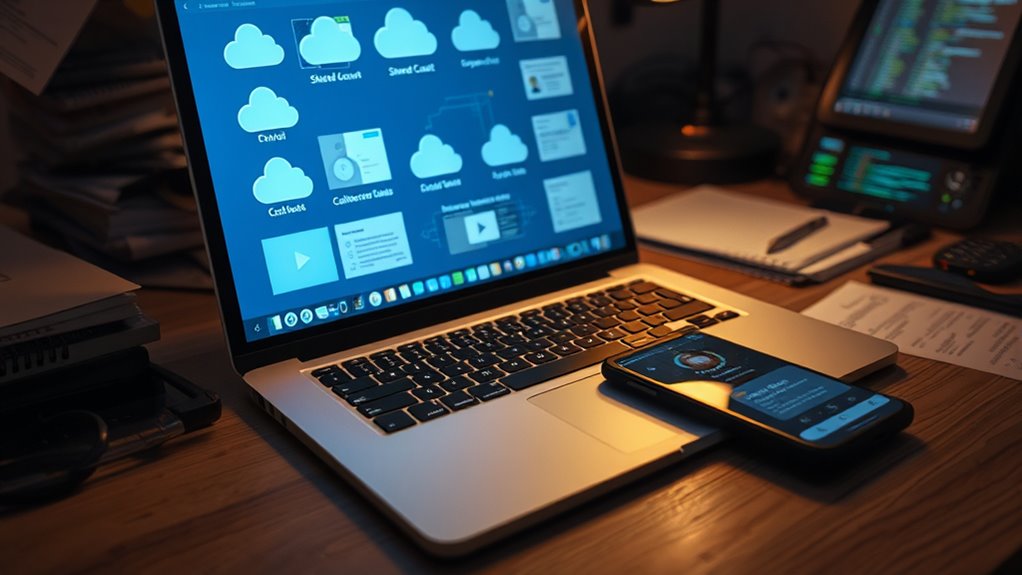Shared cloud accounts and data can expose security flaws that make cheating easier and compromise privacy. When multiple users access the same account, it becomes difficult to track activities or detect dishonest behavior. Sensitive information is at risk of leaks or theft, especially if proper security measures aren’t in place. If you want to understand how these vulnerabilities could be exploited and what steps you can take to protect yourself, there’s more to discover.
Key Takeaways
- Shared cloud accounts make it easier for users to hide dishonest activities and manipulate data undetected.
- Data accessed or modified through shared accounts can reveal signs of cheating or unauthorized behavior.
- Monitoring data flow and access logs helps identify suspicious activity linked to shared credentials.
- Weak security protocols in shared environments increase the risk of data breaches and uncovering malicious actions.
- Analyzing account activity and data patterns can expose attempts to cheat or exploit cloud resources.

Have you ever wondered how easy it is to cheat in the cloud? It’s a question that might seem unlikely at first, but when you consider how data flows through shared accounts and cloud platforms, it becomes more relevant. Cloud security is designed to protect your information, but vulnerabilities can still exist, especially when users don’t follow best practices. When you use shared accounts or leave data unsecured, you open doors for dishonest activities. Cheaters can exploit these weak points to access sensitive information, manipulate data, or even impersonate legitimate users. That’s why understanding what shared accounts can reveal is vital for maintaining integrity and trust in cloud environments.
Shared accounts are often the easiest entry point for someone looking to cheat in the cloud. When multiple users access a single account, it becomes difficult to track who did what, making it easier for someone to alter or misuse data without detection. For example, if a team shares login credentials for a project management app, an individual with malicious intent could change deadlines, delete files, or access confidential information undetected. This not only compromises data privacy but also erodes the security measures that keep your cloud environment safe. Cloud security protocols are supposed to prevent unauthorized access, but when shared credentials are involved, those protections are undermined. The more people with access, the higher the risk of accidental or intentional breaches.
Data privacy is another critical concern. When people share accounts or store sensitive data in the cloud, they risk exposing private information to outsiders or malicious insiders. Cheaters may leverage these vulnerabilities to gather confidential data, which could be sold, leaked, or used to commit fraud. Additionally, data privacy regulations like GDPR or HIPAA set strict standards for protecting personal information, making any breach more damaging and costly. If someone exploits weaknesses in your cloud setup, they can reveal private data, tarnish your reputation, or even face legal consequences. That’s why it’s essential to implement strong cloud security measures, such as multi-factor authentication, encryption, and strict access controls, to safeguard your data privacy. Moreover, understanding the importance of security protocols can help mitigate these risks effectively.
In essence, cheating in the cloud isn’t just about dishonesty; it’s often about exploiting lapses in security and privacy protections. Shared accounts and unsecured data can reveal much more than intended—personal details, confidential business information, or login credentials. The key to preventing such breaches lies in understanding how vulnerabilities are exploited and actively fortifying your cloud environment. Be vigilant about who has access, regularly review permissions, and adopt robust security protocols. Only then can you truly protect your data privacy and keep your cloud safe from those who might seek to cheat or misuse your information.
Frequently Asked Questions
How Can Shared Cloud Accounts Be Secured Against Unauthorized Access?
To secure shared cloud accounts from unauthorized access, you should enable multi-factor authentication, making it harder for intruders to get in. Regularly monitor access logs to spot suspicious activity early. Also, limit sharing to trusted users and enforce strong, unique passwords. By combining multi-factor authentication with consistent access monitoring, you substantially reduce the risk of unauthorized access and keep your shared data safe.
What Are the Legal Implications of Data Breaches in Shared Cloud Environments?
Like a house with open doors, shared cloud environments can expose you to legal liability and privacy violations. If a data breach occurs, you’re responsible for legal consequences, including fines and lawsuits. You could be held accountable for failing to protect sensitive information, risking reputational damage and regulatory penalties. Always guarantee proper security measures to minimize legal risks and safeguard privacy, keeping your cloud data compliant and protected.
How Does Cloud Data Sharing Impact User Privacy Rights?
You should know that cloud data sharing raises significant privacy concerns, as your personal information may be accessed or exposed without your consent. It can also challenge data sovereignty, since your data might be stored in different jurisdictions with varying privacy laws. These factors threaten your control over sensitive data, making it vital to understand how providers handle privacy and guarantee your rights are protected in shared cloud environments.
What Tools Are Available to Detect Cheating Through Shared Cloud Accounts?
You can use behavior monitoring and anomaly detection tools to spot cheating through shared cloud accounts. These tools analyze access patterns, login times, and data activity to identify unusual behavior. When activity deviates from the norm, they flag potential issues, helping you catch unauthorized sharing or suspicious actions early. By actively monitoring and detecting anomalies, you improve security and reduce the chances of cheating or misuse within shared cloud environments.
How Can Organizations Prevent Data Leaks From Shared Cloud Resources?
To prevent data leaks from shared cloud resources, you should implement strict access controls, ensuring only authorized users can access sensitive data. Use multi-factor authentication and regularly review permissions. Additionally, encrypt data both at rest and in transit to protect it from unauthorized access. By combining access controls with robust data encryption, you markedly reduce the risk of leaks and maintain better control over shared cloud information.
Conclusion
Remember, when you share accounts or data in the cloud, you’re opening a can of worms. It might seem harmless, but it can reveal more than you think. Stay vigilant and practice good security habits—otherwise, you might find yourself caught between a rock and a hard place. Don’t let shortcuts or careless sharing come back to bite you later. Trust me, it’s better to be safe than sorry when it comes to your digital secrets.








